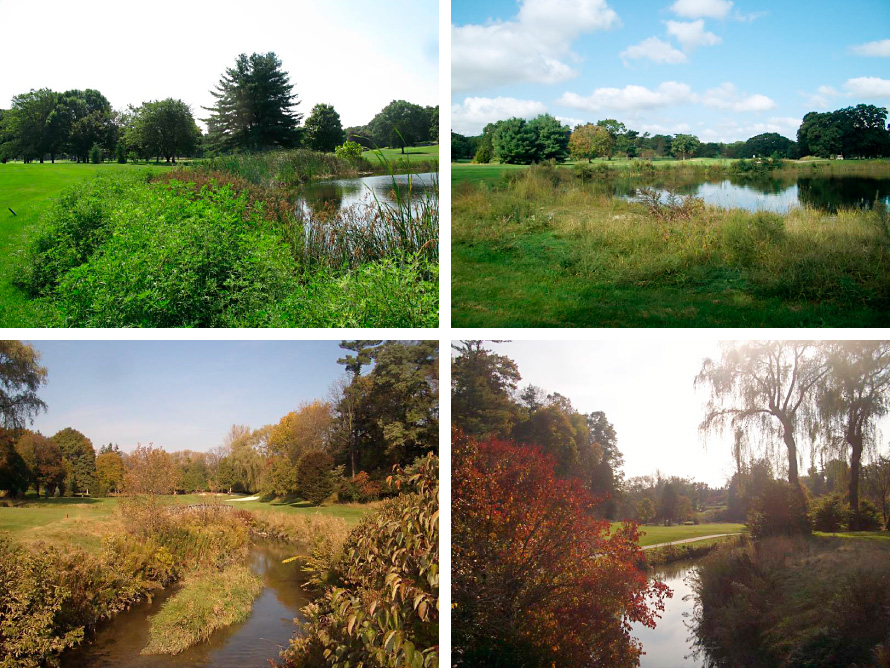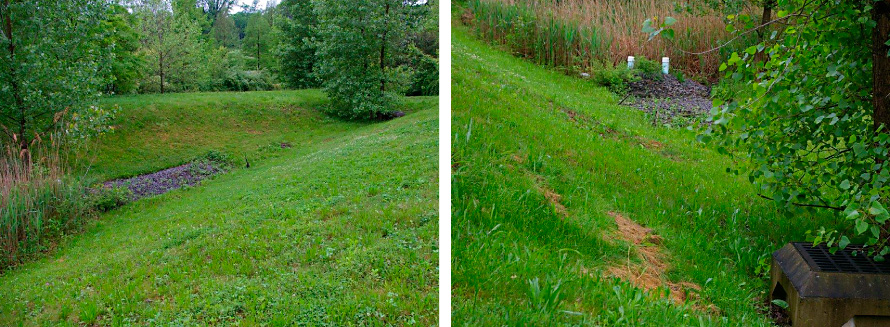Turf uses the natural processes of infiltration, filtration, and biological uptake to reduce flows and pollutant loadings. A number of vegetative practices can be used to incorporate these processes in golf course design.
Vegetative Filtration. Common examples of vegetative filters that can be used throughout the golf course are conservation areas or buffers, land absorption areas (vegetated filter strips) and swales (diversions, berms). Vegetative filters act as natural biofilters to reduce storm water flow and pollutant load, and turf areas are effective filters.
Vegetated filter strips remove sediment and attached chemicals, organic material, trace metals, and nutrients (nitrogen and phosphorus). Sediment removal rates are generally greater than 70% and nutrient removal is typically greater than 50%.
Vegetative filters require management to achieve dense, hearty vegetation. Where changes in vegetative cover must be made, these changes are normally established in low maintenance ground covers. This practice may include the use of native or naturalized plants, including low maintenance turfgrasses. When turf is used as the filtration medium, cultural activities should focus on producing healthy turf with a minimum of maintenance activities.
Turf should be allowed to grow to the highest end of the optimum range for more effective filtration. Fertilizers and pesticides are usually not applied in these areas except sparingly (sometimes during establishment to reduce erosion and runoff problems much faster) or after a risk assessment has determined that application of certain materials will have no impact in adjacent areas. Establishing these buffers reduces erosion and sediment loss decreases. Buffers also protect surface waters by attenuating pollutants in surface runoff.
Soil surface runoff may also be moderated, reducing the impact on receiving water bodies and streams. The greatest benefit is the protection of adjacent ecologically sensitive areas—potential pollutants are simply not introduced, or are introduced on a limited basis compared to more highly maintained turf areas. Figure 4-1 shows several examples of vegetated buffers.
Conservation Areas or Buffers. These are areas where it is critical to establish and maintain perennial vegetative cover to protect resources. The most sensitive portions of watercourses are the areas immediately adjacent to the water. Disturbance within and adjacent to watercourses can degrade water quality by increasing the availability and transport of pollutants. Therefore, retaining vegetated buffers along watercourses is one of the most effective practices used to protect water quality and should be designed to handle the anticipated runoff. If the area is a state or locally designated wetland, a buffer may be required and the width of the buffer specified by the regulating authority.
Critical Area Planting. Planting vegetation on highly erodible or critically eroding areas also protects water quality. The greatest amount of soil erosion and sediment delivery to surface waters occurs when large areas are graded during the construction phase, which requires phased construction to minimize the amount of bare land. Quickly establishing vegetation reduces the movement of materials in runoff, as plants take nutrients in the soil and reduce the amount that can be washed into surface waters or leach into groundwater, as well as trap particulates.
 Vegetative buffers. Source: Jennifer Grant.
Vegetative buffers. Source: Jennifer Grant.
Sodding is an important consideration in these areas since it provides instant ground cover and rooting can occur rapidly for permanent establishment. In certain instances, strip sodding rather than solid sodding can be used if the slopes are not too steep and the strips are wide enough to adequately handle the sediment carried in the runoff. However, sod production systems that use inputs can potentially contribute to water quality issues after installation; pesticides have been found in groundwater monitoring wells on very sandy sites following sodding.
Grassed Swales or Berms or Diversions. Channels constructed across a slope with a supporting ridge on the lower side are another effective control. These channels stabilize a runoff area and reduce sheet and rill erosion by reducing the length of slope. These measures also eliminate vertical channeling and large gullies, which reduces the amount of sediment and related pollutants delivered to the surface waters.
Berms direct water into specific areas to allow vertical filtration rather than allowing surface runoff. Vegetated swales are used to permit filtering and infiltration of storm water. The grasses for these swales should be water tolerant and erosion resistant (rapid germination and establishment to form dense sod). These types of swales are used on gentle slopes where slower velocities enhance the filtering and infiltration processes.
Swales are also effective in routing water to maximize contact time of water and vegetation. An example in which swales are helpful is the routing of water from the underdrains of greens. Filtration can be greatly increased by carefully choosing the route of water from the underdrain. If space is limited, drainage water could be directed to flow along a path that maximizes the distance of contact with vegetation, rather than choosing the shortest route to the lowest elevation. The effectiveness of swales in reducing flows and pollutants is similar to that of filter strips.
Vegetated Filter Strips. Filter strips are manmade or naturally occurring flat areas established at the perimeter of disturbed or impervious areas to intercept runoff as sheet flow and remove particulate matter and contaminants. Either grassed or wooded areas can function as filter strips.
Grassed Waterways. These natural or constructed channels are shaped, graded, and planted to ensure the stable flow of runoff. This practice reduces erosion in a concentrated flow area, such as in a gully or in ephemeral gullies, and reduces sediment and substances delivered to receiving waters. Vegetation may also filter some of the sediment delivered to the waterway; however, filtration is a secondary function of a grassed waterway.
Any chemicals applied to the waterway in treating the adjacent areas may wash directly into the surface waters when runoff occurs shortly after spraying. If standing water is present, applications of fertilizer or pesticides should also be avoided.
Turfgrass used as a Vegetative Filter. One of the most effective BMPs for protection of surface water is use of turf as a vegetative filter in swales and filter strips. Turfgrass areas are extremely effective in reducing soil losses compared to other cropping systems. In a comparison of soil loss from conventional agriculture with soil loss from turf, measured soil loss from tobacco production (4210 lbs/acre) was 842 times higher than from turf areas (5 lbs/acre), even with a slope of 16% on a silt loam soil.
Where polluted runoff from agricultural areas has occurred, establishment of turf buffer strips of only 15 feet have been shown to improve water quality. Studies at Oklahoma State University have shown that turfgrass buffers of 16 ft effectively reduce concentrations of chemicals in runoff (Cole et al 1997). Other studies noted that in cases where water quality has declined due to agricultural practices that lead to loss of nutrients and erosion, grass buffer strips placed between treated fields and surface waters significantly reduce the problem. This result is related to the architecture of the turf canopy, the fibrous turf root system, and the development of a vast macropore soil structural system that encourages infiltration rather than runoff.
 Grass filter strips discharging into water filtration basins. Source: Robert Alonzi.
Grass filter strips discharging into water filtration basins. Source: Robert Alonzi.
Turf density, leaf texture, rooting strength, and canopy height physically restrain soil erosion and sediment loss by dissipating impact energy from rain and irrigation water droplets. These turf features also provide resistance to surface movement of water over turf. Additionally, turfgrasses have an extensive fibrous root system, with 80% of the root mass found in the upper 4 inches of the soil profile. The combination of turf canopy and root mass has a strong soil stabilizing effect.
